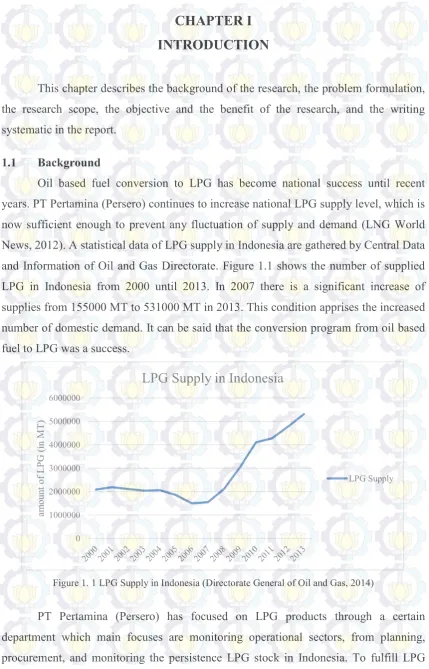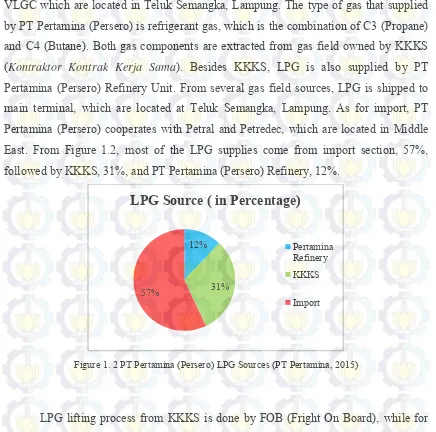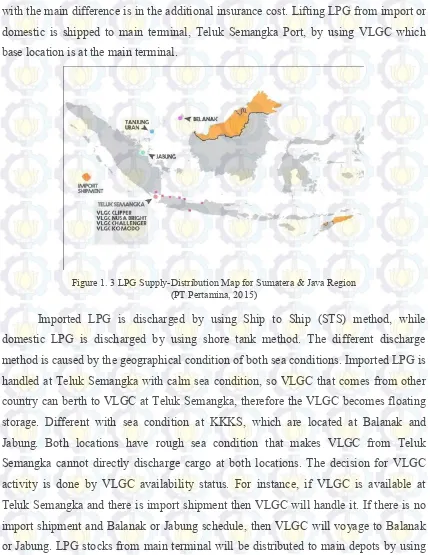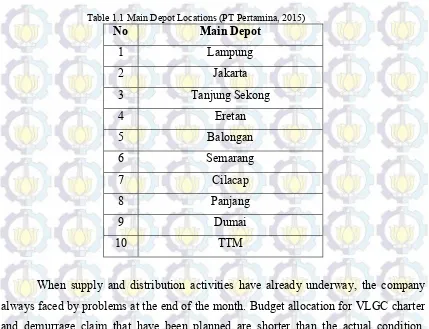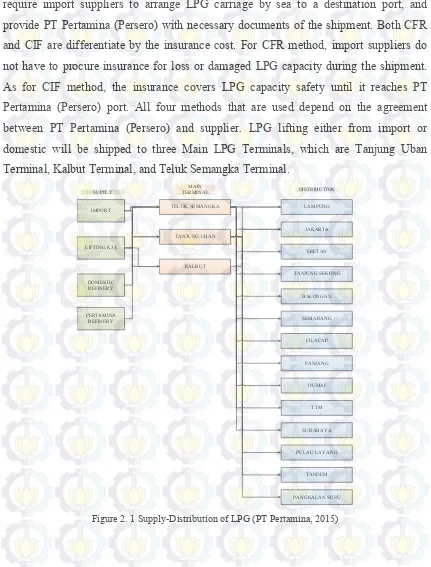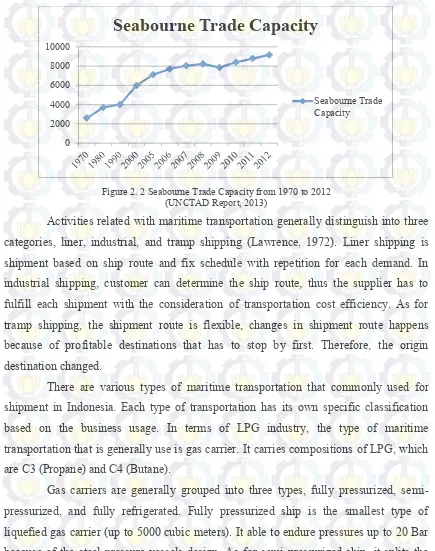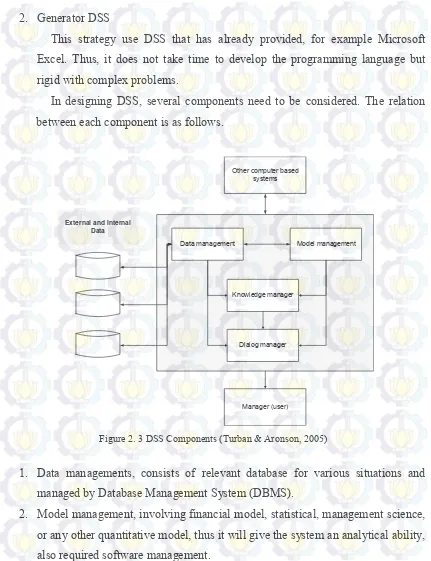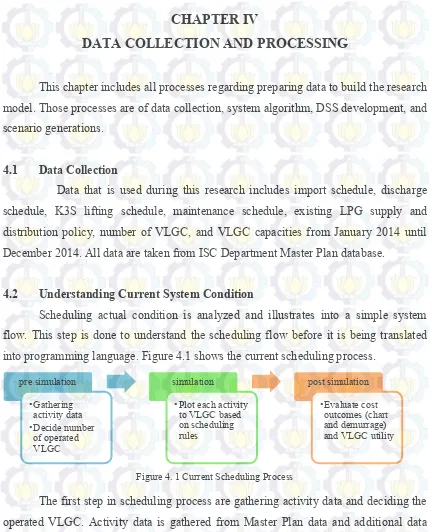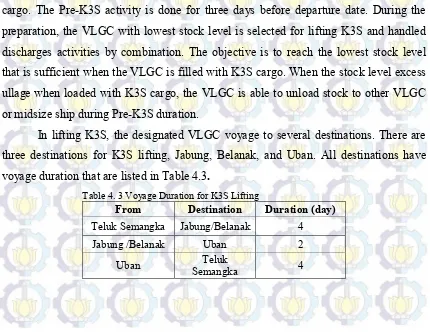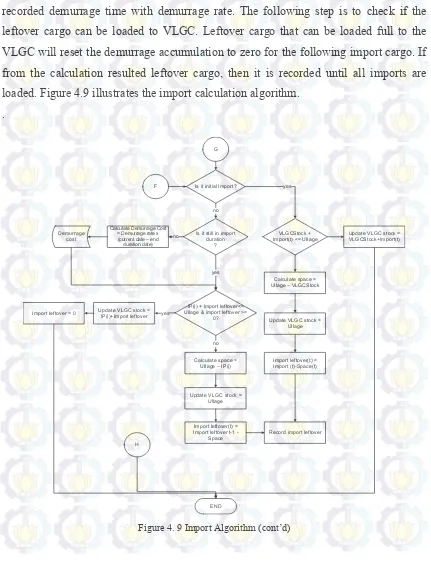FINAL PROJECT – TI 141501
DEVELOPMENT OF DECISION SUPPORT SYSTEM FOR SCHEDULING LPG SUPPLY-DISTRIBUTION AT TELUK SEMANGKA PORT (CASE STUDY: PT. PERTAMINA PERSERO)
GIOVANNI SENDE CLARK
NRP 2511 100 159
Supervisor
Prof. Ir. I Nyoman Pujawan., M.Eng., Ph.D., CSCP
INDUSTRIAL ENGINEERING DEPARTMENT
Faculty of Industrial Technology
FINAL PROJECT – TI 141501
DEVELOPMENT OF DECISION SUPPORT SYSTEM FOR SCHEDULING LPG SUPPLY-DISTRIBUTION AT TELUK SEMANGKA PORT (CASE STUDY: PT. PERTAMINA PERSERO)
GIOVANNI SENDE CLARK
NRP 2511 100 159
Supervisor
Prof. Ir. I Nyoman Pujawan., M.Eng., Ph.D., CSCP
INDUSTRIAL ENGINEERING DEPARTMENT
Faculty of Industrial Technology
i
DEVELOPMENT OF DECISION SUPPORT SYSTEM FOR
SCHEDULING LPG SUPPLY-DISTRIBUTION AT TELUK
SEMANGKA PORT
(CASE STUDY: PT. PERTAMINA PERSERO)
Student Name : Giovanni Sende Clark Student ID : 2511100159
Supervisor : Prof. Ir. I Nyoman Pujawan, M. Eng., Ph.D., CSCP.
ABSTRACT
PT Pertamina (Persero) as the main contributor for LPG supply and distribution in Indonesia relies on the VLGC (Very Large Gas Capacity) for upstream transportation mode. All upstream activities are happened at Teluk Semangka Port, which is the main terminal for import supply and regional distribution throughout Java and Sumatra. The complexity in scheduling VLGC caused time consuming and high cost (demurrage cost and charter cost). Current report stated that through 2007 until 2013, there is a significant demurrage cost increased. This condition can jeopardized the supply and distribution process because of large budget allocation for covering the demurrage cost along with VLGC charter cost. A Decision Support System (DSS) is developed to generate schedule for each operated VLGC that both save time and gives the user recommendation in reducing cost. Several factors are considered in designing the DSS, such as lifting prioritization, demurrage cost, charter cost, and VLGC utilization. Besides its ability to generate complex schedule, an easy to use interface is designed for user to interact with the DSS. From several trials using real data taken from company database, it resulted five operated VLGCs as the best number of VLGCs to be operated. Therefore, it can be a recommendation for deciding the number of operated VLGCs in the following year.
i
DEVELOPMENT OF DECISION SUPPORT SYSTEM FOR
SCHEDULING LPG SUPPLY-DISTRIBUTION AT TELUK
SEMANGKA PORT
(CASE STUDY: PT. PERTAMINA PERSERO)
Student Name : Giovanni Sende Clark Student ID : 2511100159
Supervisor : Prof. Ir. I Nyoman Pujawan, M. Eng., Ph.D., CSCP.
ABSTRACT
PT Pertamina (Persero) as the main contributor for LPG supply and distribution in Indonesia relies on the VLGC (Very Large Gas Capacity) for upstream transportation mode. All upstream activities are happened at Teluk Semangka Port, which is the main terminal for import supply and regional distribution throughout Java and Sumatra. The complexity in scheduling VLGC caused time consuming and high cost (demurrage cost and charter cost). Current report stated that through 2007 until 2013, there is a significant demurrage cost increased. This condition can jeopardized the supply and distribution process because of large budget allocation for covering the demurrage cost along with VLGC charter cost. A Decision Support System (DSS) is developed to generate schedule for each operated VLGC that both save time and gives the user recommendation in reducing cost. Several factors are considered in designing the DSS, such as lifting prioritization, demurrage cost, charter cost, and VLGC utilization. Besides its ability to generate complex schedule, an easy to use interface is designed for user to interact with the DSS. From several trials using real data taken from company database, it resulted five operated VLGCs as the best number of VLGCs to be operated. Therefore, it can be a recommendation for deciding the number of operated VLGCs in the following year.
iii
ACKNOWLEDGMENT
All grace, guidance, and blessing to the Mighty Lord that the author can finish this final research entitled “Development of Decision Support System for Scheduling LPG Supply-Distribution at Teluk Semangka Port (Case Study: PT. Pertamina Persero)” by the end of fourth year of study in Department of Industrial Engineering of Institut Teknologi Sepuluh Nopember (ITS) Surabaya.
This final research is conducted as a requisite to finish Industrial Engineering major and to achieve Bachelor degree from Institut Teknologi Sepuluh Nopember (ITS). During the completion of this research, the author receives countless support, motivation, inspiration, and help from various people and communities. Therefore, in this opportunity, the author would like to express his biggest appreciation and gratitude to those who contribute the most and play important part during the study and especially completion of this final research, namely:
1. Both parents, David Ika Bhakti Situmeang and Christine Situmeang that support throughout the study. For the financial support and motivation, the writer felt gratitude.
2. Prof. Ir. I Nyoman Pujawan, M.Eng., Ph.D., CSCP., as supervisor, head of laboratory and the best lecturer for the author, under whose great guidance, clear direction, patient supervision, and wise advise in tutoring the author for the whole time, this final research as well as the author’s bachelor study can finish on time.
3. Mr. Henry K Sutatio, Mas Andhika Pratama, and Mas Rangga Galih Pratama from PT Pertamina (Persero) that accepted the writer to do the research and providing related data.
4. Prof. Ir. Budi Santosa, M.Sc., Ph.D., as head of Department of Industrial Engineering and Putu Dana Karningsih ST., M.Eng.Sc., Ph.D., as secretary of Department of Industrial Engineering, whose support and advise have helped the author for the last couple years.
iv
6. Prof. Iwan Vanany, Dr. Ahmad Rusdiansyah, and Dr. Imam Baihaq, as lecturer members of Laboratory of Logistics and Supply Chain Management, whose motivating advise, inspiring guidance, and supportive coordination have been an integral part during lab engagements.
7. All faculty members and academic staffs of Department of Industrial Engineering of Institut Teknologi Sepuluh Nopember, for all knowledge, experience, and help for the author and other friends and students during the years of study.
8. Beloved brothers, Timothy Pardomuan Karre Situmeang and Ian Parulian Matangkin Situmeang, that really motivate their brother to finish his thesis.
9. Dearest LSCM laboratory assistants, alumni, and friends: Kelvin, Gane, Willy, Reika, Khalida, Ivana, Wahyu, Khara, Evan, Elsa, Mibol, Nupi, Doni, Erza, and Odel who have been the best colleagues, mood-boosters. 10.Cenkgoer TI-MB, through all the postings and memes that are discussed
motivate the writer to write the thesis
The author realizes that this research is far from perfect. Therefore, the author welcomes positive suggestion and constructive critics from anyone. May this research contribute to academic world and provide improvement for better future.
Last, the writer would like to dedicate this final research to his beloved grandfather. Through his wisdoms and motivations the writer has the eager to finish his research. Thank you Ompung ..
Surabaya, 25 June 2015
v
TABLE OF CONTENTS
ABSTRACT ... i
ACKNOWLEDGMENT ………...………...iii
TABLE OF CONTENTS ...v
LIST OF TABLES ... ix
LIST OF FIGURES ... xi
CHAPTER I INTRODUCTION ... 1
1.1 Background ... 1
1.2 Problem Identification ... 5
1.3 Research Objective ... 5
1.4 Research Benefit ... 5
1.5 Research Scope ... 5
1.5.1 Limitation ... 5
1.5.2 Assumption ... 6
1.6 Report Outline ... 6
CHAPTER II LITERATURE REVIEW ... 9
2.1 LPG Supply Chain in Indonesia ... 9
2.2 Maritime Transportation ... 11
2.2.1 Demurrage ... 13
2.2.2 Ship Charter ... 13
2.3 Ship Routing and Scheduling ... 15
2.4 Scheduling Algorithm ... 16
2.5 Decision Support System (DSS) ... 16
CHAPTER III RESEARCH METHODOLOGY ... 19
3.1 Data Collection ... 19
3.2 Understanding Current System Condition ... 19
vi
3.4 Decision Support System (DSS) Development ... 20
3.4.1 Designing Initial DSS Framework ... 20
3.4.2 Data-management subsystem (DBMS) Design ... 20
3.4.3 Model management subsystem (MBMS) development ... 20
3.4.4 User interface subsystem development ... 20
3.4.5 DSS application development ... 21
3.5 DSS Validation ... 21
3.6 Numerical Experiment ... 21
3.7 Conclusion and Recommendation ... 21
CHAPTER IV DATA COLLECTION AND PROCESSING ... 23
4.1 Data Collection ... 23
4.2 Understanding Current System Condition ... 23
4.3 Defining Specific User Requirements ... 26
4.4 System Assignment Algorithm ... 27
4.4.1 Pre-K3S Algorithm ... 28
4.4.2 Shortage Supports for Pre-K3S Algorithm ... 31
4.4.3 K3S Lifting Algorithm ... 34
4.4.4 Discharge Algorithm ... 35
4.4.5 Import Algorithm ... 36
4.5 DSS Development ... 39
4.5.1 Interface ... 39
4.5.2 Input ... 40
4.5.3 Process ... 43
4.5.4 Output ... 45
vii
CHAPTER V NUMERICAL EXPERIMENT ... 53
5.1 1st Trial ... 53
5.1.1 Initial Condition ... 53
5.1.2 Scenario Condition ... 55
5.1.3 Result Comparison ... 57
5.2 2nd Trial ... 60
5.2.1 Initial Condition ... 61
5.2.2 Scenario Condition ... 62
5.2.3 Result Comparison ... 64
CHAPTER VI CONCLUSION AND RECOMMENDATION ... 69
6.1 Conclusion ... 69
6.2 Recommendation ... 69
REFERENCES ... ix
ix
LIST OF TABLES
Table 1.1 Main Depot Locations (PT Pertamina, 2015) ... 4
Table 2.1 LPG Supply Sources (PT Pertamina, 2015) ... 9
Table 4. 1 Lifting Activities Description ... 24
Table 4. 2 Scheduling Rules ... 24
Table 4. 3 Voyage Duration for K3S Lifting ... 25
Table 5. 1 Input Data for Initial Condition (1st Trial) ... 53
Table 5. 2 Demurrage Recap (1st Trial-Initial Condition) ... 53
Table 5. 3 Input Data (1st Trial – Scenario Condition) ... 56
Table 5. 4 Scenario Result (1st Trial-Scenario Condition) ... 56
Table 5. 5 DSS Results for Initial Condition and Scenarios (1st Trial) ... 57
Table 5. 6 Input Data for Initial Condition (2nd Trial) ... 61
Table 5. 7 Scenario Data Input (2nd Trial) ... 62
Table 5. 8 Scenario Results (2nd Trial) ... 63
vii
LIST OF FIGURES
Figure 1. 1 LPG Supply in Indonesia (Directorate General of Oil and Gas, 2014) 1
Figure 1. 2 PT Pertamina (Persero) LPG Sources (PT Pertamina, 2015) ... 2
Figure 1. 3 LPG Supply-Distribution Map for Sumatera & Java Region ... 3
Figure 2. 1 Supply-Distribution of LPG (PT Pertamina, 2015) ... 10
Figure 2. 2 Seabourne Trade Capacity from 1970 to 2012 ... 12
Figure 2. 3 DSS Components (Turban & Aronson, 2005)... 18
Figure 3. 1 Research Flowchart ... 22
Figure 4. 1 Current Scheduling Process ... 23
Figure 4. 2 General Scheduling Algorithm ... 27
Figure 4. 3 Pre-K3S Algorithm ... 29
Figure 4. 4 Minimum VLGC Quantities Selection ... 30
Figure 4. 5 Shortage Option Algorithm ... 33
Figure 4. 6 K3S Departure Algorithm ... 34
Figure 4. 7 Discharge Algorithm ... 35
Figure 4. 8 Import Algorithm ... 37
Figure 4. 9 Import Algorithm (cont’d) ... 38
Figure 4. 10 DSS Interface ... 39
Figure 4. 11 VLGC Database Input ... 40
Figure 4. 12 Discharge Schedule Input ... 41
Figure 4. 13 K3S Lifting Schedule Input ... 42
Figure 4. 14 Import Schedule Input ... 42
Figure 4. 15 Maintenance Schedule Input ... 43
Figure 4. 16 Process Section Appearance ... 44
Figure 4. 17 Output Appearance ... 46
Figure 5. 1 VLGC Utilization Graph (July-October 2013) ... 55
Figure 5. 2 Demurrage Cost Graph (July 2013 – October 2013)………56
Figure 5. 3 Charter Cost (July-October 2013) ... 59
Figure 5. 4 Demurrage Cost and Charter Cost Graph (1st Trial)... 59
viii
Figure 5. 6 VLGC Utilization (2nd Trial-Initial Condition) ... 62
Figure 5. 7 Demurrage Cost Graph from July-October2014 (2nd Trial) ... 66
Figure 5. 8 VLGC Charter Cost from July-October 2014 (2nd Trial) ... 67
Figure 5. 9 Demurrage Cost and Charter Cost Graph (2nd Trial) ... 67
xlix
AUTHOR BIOGRAPHY
Giovanni Sende Clark Situmeang is an Industrial Engineering student of class 2011. The writer was born at 12th April 1993 in Jakarta. During his study, the writer was actively involved in several activities. The writer has joined HMTI ITS as Fund Raising Coordinator, Sponsorship Coordinator of YES Summit 2013, and assistant coordinator of LSCM (Logistic and Supply Chain Management) Laboratory period 14/15.
Several competitions have been participated by the writer. The writer has participate at APICS Global Student Challenge 2014 and 2015. Besides academic, the writer also enjoys several hobbies such as playing music, watching music gigs, and watching movies. Because of the enthusiasm for music, the writer with his fellow Kelvin Adisetya, start a music event “Rooftop Session”.
In his third year of study, the writer had an internship at PT Adaro Logistic. The writer was involved at Supply Chain Department. Besides that, the writer also joined as research intern at PT Pertamina (Persero), assigned at ISC (Integrated Supply Chain) Department. For laboratory activity, the writer was involved in several researches and projects. The writer can be contacted via email at [email protected].
1
CHAPTER I
INTRODUCTION
This chapter describes the background of the research, the problem formulation, the research scope, the objective and the benefit of the research, and the writing systematic in the report.
1.1 Background
Oil based fuel conversion to LPG has become national success until recent years. PT Pertamina (Persero) continues to increase national LPG supply level, which is now sufficient enough to prevent any fluctuation of supply and demand (LNG World News, 2012). A statistical data of LPG supply in Indonesia are gathered by Central Data and Information of Oil and Gas Directorate. Figure 1.1 shows the number of supplied LPG in Indonesia from 2000 until 2013. In 2007 there is a significant increase of supplies from 155000 MT to 531000 MT in 2013. This condition apprises the increased number of domestic demand. It can be said that the conversion program from oil based fuel to LPG was a success.
Figure 1. 1 LPG Supply in Indonesia (Directorate General of Oil and Gas, 2014)
2
supply in Indonesia, all related departments cooperate to maintain LPG supply. The departments plan the LPG supply from gas fields that are located in Indonesia, oil refinery units, and imports from other country.
PT Pertamina (Persero) depends on its transportation to support the business process. LPG cargoes are moved from one point to other point by using maritime transportation mode. Currently, PT Pertamina (Persero) has VLGC (Very Large Gas Capacity), that operate as floating capacity for supply usage and midsize ships that operate for distribution usage. Many of the ships are contracted from domestic company, and the rest are owned by PT Pertamina (Persero).
LPG shipments start from import and domestic supply that are handled by VLGC which are located in Teluk Semangka, Lampung. The type of gas that supplied by PT Pertamina (Persero) is refrigerant gas, which is the combination of C3 (Propane) and C4 (Butane). Both gas components are extracted from gas field owned by KKKS (Kontraktor Kontrak Kerja Sama). Besides KKKS, LPG is also supplied by PT Pertamina (Persero) Refinery Unit. From several gas field sources, LPG is shipped to main terminal, which are located at Teluk Semangka, Lampung. As for import, PT Pertamina (Persero) cooperates with Petral and Petredec, which are located in Middle East. From Figure 1.2, most of the LPG supplies come from import section, 57%, followed by KKKS, 31%, and PT Pertamina (Persero) Refinery, 12%.
Figure 1. 2 PT Pertamina (Persero) LPG Sources (PT Pertamina, 2015)
LPG lifting process from KKKS is done by FOB (Fright On Board), while for imported LPG, is done by CFR (Cost and Freight) or CIF (Cost, Insurance, Freight)
12%
31% 57%
LPG Source ( in Percentage)
Pertamina Refinery KKKS
3
with the main difference is in the additional insurance cost. Lifting LPG from import or domestic is shipped to main terminal, Teluk Semangka Port, by using VLGC which base location is at the main terminal.
Figure 1. 3 LPG Supply-Distribution Map for Sumatera & Java Region (PT Pertamina, 2015)
4
Table 1.1 Main Depot Locations (PT Pertamina, 2015)
No Main Depot
1 Lampung
2 Jakarta
3 Tanjung Sekong
4 Eretan
5 Balongan
6 Semarang
7 Cilacap
8 Panjang
9 Dumai
10 TTM
When supply and distribution activities have already underway, the company always faced by problems at the end of the month. Budget allocation for VLGC charter and demurrage claim that have been planned are shorter than the actual condition. Therefore, the company injects additional budget for covering the whole costs. This condition is not preferably by the Finance Department. The problem is caused when determining budget for the whole period. The budget allocation is based on the VLGC simulation that happens at the beginning of the month through group discussion.
The group discussion “simulate” the VLGC schedule by assigning each activities to each VLGC based on VLGC availability. Even though the scheduling method has been established, it is not reflected in the result. This is caused by scheduling process inconsistency. Therefore, there is a mismatch between simulated schedule and reality. From this problem, it will cause an unbalance utility between VLGC that leads to unnecessary operated VLGC. Common condition also happens when VLGCs are charted less than the reality. It resulted high demurrage claim that the company has to pay.
5
possibility that a VLGC has low utility. Therefore, the company has to make an accurate decision on how many VLGCs needed for the whole period.
From this condition, a decision support system can be the solution for this problem. Through this system, it can save time and cost. Furthermore, it may resulted several scenarios based on the number of VLGC that are going to be used. It can be a consideration for the company to chart new VLGC or divest VLGC that is crucial for the shipments for the following months.
1.2 Problem Identification
As stated in the background, this research is conducted to design a system that can merge all conditions of scheduling process and cost factors such as demurrage cost and charter cost into one tool that generates the process automatically.
1.3 Research Objective
This research aims at several objectives, i.e. to:
1. Develop a decision support system for VLGC scheduling system.
2. Obtain the best cost combination from several scenarios based on the number of VLGCs as the parameter and factors resulting it.
1.4 Research Benefit
The benefits of conducting this research are to ease the company in deciding the number of VLGCs operated for the following months. Therefore, the budget allocation for transportation becomes more efficient.
1.5 Research Scope
The scope of this research is defined by limitation and assumption.
1.5.1 Limitation
Some limitations set for this research are:
1. The research is done for supply and distribution in Sumatra and Java Region.
6
1.5.2 Assumption
Some assumptions set for this research are:
Cargo schedule is day to day time basis, which has considered shipment activities (loading, unloading, administration, etc).
Ships reliability is high.
Activity schedules (discharge, import, and KKKS lifting) are fixed.
Weather condition is not considered.
Supply sources and distribution depots are ready based on schedule.
Midsize ship is ready when it is going to be used.
1.6 Report Outline
The following systematic framework will be used in structuring the content of this research report.
CHAPTER I INTRODUCTION
This chapter describes the background, problem identification, objectives, benefits, and scope of this research. In the last part, the report outline will also be described.
CHAPTER II LITERATURE REVIEW
This chapter describes theories and concepts based on existing literatures that have been developed and are used as basis of this research. Some concepts and theories provided in this chapter are LPG Supply Chain in Indonesia, Maritime Transportation, Ship Routing and Scheduling, Scheduling Algorithm, and Decision Support System (DSS).
CHAPTER III RESEARCH METHODOLOGY
7
CHAPTER IV DATA COLLECTION AND PROCESSING
This chapter includes all processes including data collection, data processing, DSS development, DSS testing, and scenario generation.
CHAPTER V NUMERICAL EXPERIMENT
This chapter includes numerical experiments of the simulation output for all scenarios generated.
CHAPTER VI CONCLUSION AND RECOMMENDATION
8
9
CHAPTER II
LITERATURE REVIEW
This chapter describes theories and concepts based on existing literatures that have been developed and are used as basis of this research. Some concepts and theories provided in this chapter are LPG Supply Chain in Indonesia, Maritime Transportation, Ship Routing and Scheduling, and Decision Support System.
2.1 LPG Supply Chain in Indonesia
LPG supply, which consists of C3 (Propane) and C4 (Butane), starts from four supply source, import, KKKS, Domestic Refinery, and Pertamina Refinery. Import source supplied from Saudi Arabia, where PT Pertamina (Persero) cooperates with PETRAL and PETRADEC for ordering process to the suppliers. KKKS (Kontrak Kerja Kilang Swasta) sources are private gas companies that established cooperation contracts with PT Pertamina (Persero). Domestic Refinery and Pertamina Refinery are both owned by PT Pertamina (Persero). Domestic Refinery is private refinery that has been acquired and managed by PT Pertamina (Persero) subsidiary company. As for Pertamina Refinery, it is established by PT Pertamina (Persero). Detailed source names are shown in Table 2.1. It is noted that, all source have long term contract and able to fulfill the necessary demand. But for import supply, it is done when there is LPG shortage from either KKKS or Domestic Refinery.
Table 1.1 LPG Supply Sources (PT Pertamina, 2015)
Import KKKS Domestic Refinery Pertamina Refinery
Petral Bontang, PT Badak
NGL
PertaSamtan Gas Dumai
Petradec Jabung Petrochina Media Karya Sentosa Plaju
Belanak Conoco
Philips
Surya Esa Perkasa Cilacap
Arar Petrochina TPPI Balikpapan
Chevron Indonesia PDT (Pertagas) Balongan
HESS Pertamina Hulu
10
LPG lifting from KKKS and Domestic Refinery are done by using FOB (Freight On Board) method. It means that PT Pertamina (Persero) will not get charged for load placed on board at the point of shipment. As for imported LPG, it is done by CFR (Cost and Freight) method or CIF (Cost, Insurance, and Freight) method. Both methods require import suppliers to arrange LPG carriage by sea to a destination port, and provide PT Pertamina (Persero) with necessary documents of the shipment. Both CFR and CIF are differentiate by the insurance cost. For CFR method, import suppliers do not have to procure insurance for loss or damaged LPG capacity during the shipment. As for CIF method, the insurance covers LPG capacity safety until it reaches PT Pertamina (Persero) port. All four methods that are used depend on the agreement between PT Pertamina (Persero) and supplier. LPG lifting either from import or domestic will be shipped to three Main LPG Terminals, which are Tanjung Uban Terminal, Kalbut Terminal, and Teluk Semangka Terminal.
IMPORT
11
Domestic LPG can be transferred by vessel or pipe, while imported LPG is transferred by import vessel. Import vessel from Teluk Semangka and Kalbut will discharge cargo to VLGC or floating storage by using Ship to Ship (STS) method. In STS transfer method, ships are positioned alongside each other when LPG is transferred between them. Different with both terminals, Tanjung Uban Terminal transfers LPG from shore tank to ship.
LPG from main terminal then transported to destination depot in all areas in Indonesia by using pressurized ship, midsize ship, small ship, truck, and pipe. Besides main depot, LPG from main terminal also transported to RU (Refinery Unit) by using ship or pipe, for example RU- III Plaju received LPG supply from Tanjung Uban Terminal.
LPG from RU will be transferred to each depot in order to fulfill the Depot DOT (Days of Throughput). Transferred LPG from RU to depot can be done by using pipe or ship. From depot, LPG is transferred to SPBE (Stasiun Pengisian Bulk Elpiji) or also directly to industries that use LPG as their main energy source.
At SPPBE (Stasiun Pengumpulan dan Pengisian Bahan Bakar Elpiji), LPG is bottled to three types of canisters, 3 kg, 12 kg, and 50 kg. After that, LPG in form of canisters are delivered to agent or household.
2.2 Maritime Transportation
12
Figure 2. 2 Seabourne Trade Capacity from 1970 to 2012 (UNCTAD Report, 2013)
Activities related with maritime transportation generally distinguish into three categories, liner, industrial, and tramp shipping (Lawrence, 1972). Liner shipping is shipment based on ship route and fix schedule with repetition for each demand. In industrial shipping, customer can determine the ship route, thus the supplier has to fulfill each shipment with the consideration of transportation cost efficiency. As for tramp shipping, the shipment route is flexible, changes in shipment route happens because of profitable destinations that has to stop by first. Therefore, the origin destination changed.
There are various types of maritime transportation that commonly used for shipment in Indonesia. Each type of transportation has its own specific classification based on the business usage. In terms of LPG industry, the type of maritime transportation that is generally use is gas carrier. It carries compositions of LPG, which are C3 (Propane) and C4 (Butane).
Gas carriers are generally grouped into three types, fully pressurized, semi-pressurized, and fully refrigerated. Fully pressurized ship is the smallest type of liquefied gas carrier (up to 5000 cubic meters). It able to endure pressures up to 20 Bar because of the steel pressure vessels design. As for semi-pressurized ship, it splits the storage tank for pressurized and refrigerated type of gasses. Therefore, it becomes an advantage because of the ability to load or discharge more than one type of gas. Fully refrigerated ship is built to carry liquefied gasses between fully refrigerated storage terminals at low temperature and atmospheric pressure.
13 2.2.1 Demurrage
The terms of demurrage is the penalty cost that PT Pertamina (Persero) used for unfinished import unloading process in daily time basis. As stated in the background, import cargoes are handled by PETRAL and PETRADEC, which both companies handle the import shipments until it arrives at Teluk Semangka. Thus, the amount of penalty is based on agreement between PETRAL, PETRADEC, and ISC Department. To calculate the demurrage time, it follows the following equation.
(2.1)
Demurrage time in Equation 2.1 calculates the gap between the actual duration and agreed duration of unloading process. Total laytime used is the time span between import ship arrivals until departures. As for laytime allowed is the agreed time for import ship to unload the cargo to VLGC until due date. Therefore, to calculate the demurrage cost is as follows.
(2.2)
Demurrage cost in Equation 2.2 is used when there is a time gap in Equation 2.1. If so, then it is multiply by the demurrage rate which is based on contract between PETRAL, PETRADEC, and ISC Department.
2.2.2 Ship Charter
Charter contract is the negotiation between ship owner and individual who wants to use ship as mode of transportation (Ozer & Cetin, 2012). There are several types of ship charter that are commonly use, such as bareboard charter, time charter, and voyage charter (Custom and Excise Module Team, 2008). Several types of ship charter are as follows:
1. Time charter, charter tariff is based on ship charter duration. In time charter, charter payment is in cost per day or cost per DWT tonnage. Charter cost allocations are as follows:
14 Depreciation cost
Insurance cost Ship crew cost
Ship maintenance cost Supplies and lubricants cost Overhead cost
Ship tenant: Charter cost Bunker cost Port cost Stevedoring Cargodoring Water
Loading-unloading company
2. Voyage charter, transport goods from loading source to unloading destination. In voyage charter it includes demurrage cost, which is cost that claimed to tenant if tenant late to unload goods from ship. However, if tenant is able to unload goods faster than duration, then the tenant will receive dispatch. Cost allocation in voyage charter are as follows:
Ship owner:
Capital cost Depreciation cost Ship crew cost
Ship maintenance cost Supplies and lubricants cost Insurance cost
15 Ship Tenant:
Ship charter cost based on lifted weight for one shipping.
2.3 Ship Routing and Scheduling
Ship scheduling plays an important part in planning ship operations. It consists of detailed ship assignment, where and when a shipment will be done. Ronen (1993) stated that even though ship scheduling seems rigid, where a certain fleet must carried a set of shipments, it enables flexibility in the process for both ship (size and timing) and its availability (chartering in or out, lay ups, and spot charters). Thus, revisions often happen in order to have an optimal schedule.
Ship planning problem can be differentiate based on the planning horizon into three categories, strategic, tactical, and operational (Christiansen and Fagerholt, 2002). In strategic problem, it can be classified into several problems, market decision, ship design, transportation network design, fleet assignment (capacity, route, and ship type), location, and port design. As for tactical and operational, both mainly focus on routing and scheduling (Christiansen and Fagerholt, 2002). Tactical considers size and combination changes of assigned ship fleet, assignment for specific ship to trade route, ship routing and scheduling, inventory ship routing, berth scheduling, crane scheduling, container yard management, container stowage planning, ship management, and empty container distribution. And for operation, it generally deals with ship speed and ship loading process.
16
2.4 Scheduling Algorithm
There are several operational scheduling algorithm that can be applied for ship scheduling. Ulfija (2007) analogized the ship as machine and activities as line of works that are waiting to be processed.
In scheduling, the algorithm usage is depends on designated priority. Several scheduling priority are as follow:
1. Random, priority rule based on random task. It does not considers whether the task needs to be handle first or last.
2. Smallest Processing Time (SPT), operational schedule based on the shortest operational time, commonly it is chosen to minimalized flow time.
3. First Come First Served (FCFS), scheduling based on activity arrival. This rule will choose job with earliest arrival time into the work center.
4. Earliest Due-Date (EDD), operation schedule to choose job with shortest due-date. The main goal is to minimalize lateness or tardiness. Referring to this research, there is a certain activity where the due date is more than one day, different with other activity. The due date is for three days, and after three days it does not able to unload then there is a certain cost that the company has to pay.
5. Critical Ratio (CR), schedule with smallest ratio between slack and available time until job due. Critical ratio is define as residue work time divided with amount of residue work time ratio with slack time.
Referring to one of the main goal of this research, which is to minimize the demurrage cost, the suitable priority rule is Earliest Due Date (EDD). This concept fits with the supply-distribution activities in this research where there are different due date for each activities.
2.5 Decision Support System (DSS)
17
tools, which are used to capture the situation and increase the effectiveness of decision making.
According to Simon (1960), there are two types of decisions:
1. Programmed decision, repeated and routine decision. Company develops certain ways to control the decision. (e.g. arranging store products).
2. Unprogrammed decision, decision that happens only once and tends to be unstructured, if compared with programmed decision. (e.g. deciding what products to be sold).
In terms of maritime logistics and distribution, DSS becomes a usable tool for developing a ship schedule. Brown et al (1987) used DSS for developing a schedule system for crude oil ships by using set-partitioning model. The result showed that by using DSS it obtained optimal integer solutions in less than a minute. Further research by Downman et al (1995) showed that an implementation of DSS for solving US Coast Guard schedule resulted an annual saving up to US$30 million. Therefore, applying DSS for scheduling may result efficiency for both time and budget.
Besides operational benefits of applying DSS, it can be used to determine strategic plan (Korpela & Tuominen, 1996). Blanning (1979) defined several characteristic of DSS:
1. DSS facilitate the interaction between computer and decision-makers 2. DSS helps manager to make an unstructured decision
3. DSS provides information for several activities, i.e. planning, finance, marketing, and operational function.
Considering both benefits, this research fits with the desires from the researcher and company. It is also because the massive data, problem complexity, and numerous regulations related with the decisions that makes DSS suitable for this research.
To design and analyze a DSS, Asihanto (2010) suggested two types of strategies that can be used. Those are Specific DSS and Generator DSS.
1. Specific DSS
18 2. Generator DSS
This strategy use DSS that has already provided, for example Microsoft Excel. Thus, it does not take time to develop the programming language but rigid with complex problems.
In designing DSS, several components need to be considered. The relation between each component is as follows.
Other computer based systems
Data management Model management
Knowledge manager
Dialog manager
Manager (user)
External and Internal Data
Figure 2. 3 DSS Components (Turban & Aronson, 2005)
1. Data managements, consists of relevant database for various situations and managed by Database Management System (DBMS).
2. Model management, involving financial model, statistical, management science, or any other quantitative model, thus it will give the system an analytical ability, also required software management.
3. Communication (dialog subsystem), user can communicate and give order to DSS through this subsystem.
19
CHAPTER III
RESEARCH METHODOLOGY
This chapter describes all steps conducted in this research so that the research can run in systematic way.
3.1 Data Collection
In this step, data related with the research will be gathered. After data have been gathered, data are processed to achieve the solution. Data that are gathered are:
1. Existing LPG supply & distribution policy. 2. Import shipment schedule.
3. KKKS lifting schedule (Jabung-Uban schedule and Belanak-Uban schedule). 4. Depot discharge schedule.
5. Maintenance schedule. 6. Number of VLGC. 7. VLGC capacity.
All data are gathered from Master Plan database ISC Department and interview with related employees.
3.2 Understanding Current System Condition
In designing a DSS, it is required to have a thorough understanding of the current system condition. Both the developer and the user must have the same understanding on the scheduling system that has already established by ISC Department. The DSS developer obtained the knowledge by an interview with employees that in charge the scheduling process and also from schedule simulation group discussion.
3.3 Defining Specific User Requirements
20
with users. Through interview session with users, all necessary requirements that need to be included in DSS can be used by users. Requirement lists from users are translated into algorithms which are used for the following steps.
3.4 Decision Support System (DSS) Development
In this step, algorithms that have been defined are translated into programming language. It is then being used for designing DSS in VBA (Visual Basic Application) Microsoft Excel.
3.4.1 Designing Initial DSS Framework
Applied DSS is designed based on the initial framework that is being processed in this step. It consists of defining used decision model, input data, expected output, data file format, and also the DSS procedures.
3.4.2 Data-management subsystem (DBMS) Design
Database system which consists of relevant data is designed and managed by database management system (DBMS). It stores large size of data that are compatible with the problem that DSS has been designed to and provides logical data structure in which user interacts. Therefore, the user is separated from physical aspects of database structure and processing. Furthermore, the user is informed of available data and how to access the data.
3.4.3 Model management subsystem (MBMS) development
The role of MBMS is to transform data from DBMS into useful information in making decision. Since many problems that the user of a DSS will cope with may be unstructured, the MBMS should also be capable of assisting the user in model building (Druzdzel & Flynn, 2002).
3.4.4 User interface subsystem development
21 3.4.5 DSS application development
The final step of designing DSS is integrating all DSS components into an integrated program, so it can easily interact with the user.
3.5 DSS Validation
In this stage, the DSS is tested, evaluated, and deployed a fully function DSS. For testing the DSS, it is done by validation. Testing the validation is done in two steps. First step is done to ensure that no error occurred when DSS is running. The next step is to assure that DSS runs according to the program logic. Both steps need to be conducted to make sure that input, process, and output are integrated and according to the algorithm.
3.6 Numerical Experiment
The next step after validating DSS is to generate several trials. The trials are generated based on supply and distribution historical data from 2013 and 2014. On both trials, the scenarios are generated by changing the number of operated VLGCs. The outputs for each trial are number of operated VLGCs, utilization of each VLGCs, charter cost, and demurrage cost. Then, results that are given from each trial are calculated in determining which combination is optimal to be applied.
3.7 Conclusion and Recommendation
22
START
DATA GATHERING
· Existing LPG supply and distribution policy
· System algorithm Untested DSS application
DSS TESTING VLGC, VLGC utility, charter cost, demurrage
23
CHAPTER IV
DATA COLLECTION AND PROCESSING
This chapter includes all processes regarding preparing data to build the research model. Those processes are of data collection, system algorithm, DSS development, and scenario generations.
4.1 Data Collection
Data that is used during this research includes import schedule, discharge schedule, K3S lifting schedule, maintenance schedule, existing LPG supply and distribution policy, number of VLGC, and VLGC capacities from January 2014 until December 2014. All data are taken from ISC Department Master Plan database.
4.2 Understanding Current System Condition
Scheduling actual condition is analyzed and illustrates into a simple system flow. This step is done to understand the scheduling flow before it is being translated into programming language. Figure 4.1 shows the current scheduling process.
Figure 4. 1 Current Scheduling Process
The first step in scheduling process are gathering activity data and deciding the operated VLGC. Activity data is gathered from Master Plan data and additional data such as VLGC available list from Operational Department and budget allocation from Finance Department. There are three main lifting activities during scheduling process, K3S (Kontrak Kilang Swasta) lifting, discharge lifting, and import lifting. Both K3S (Kontrak Kilang Swasta) activity and import activity are define as supply activity. Whereas discharge activity is defined as distribution activity. Each lifting activity is
24
described in Table 4.1. Coincide with data gathering, the group decides on the number of operated VLGC for simulation process. The decision is based on historical data.
Table 4. 1 Lifting Activities Description
Activity Type Lifting Activity Description
Supply
K3S (Kontrak Kilang Swasta)
Lift LPG cargo from three location, Jabung, Uban, and Belanak.
Import Lift LPG cargo from import ship that berths at Teluk Semangka Port
Distribution Discharge Unload LPG cargo from VLGC to
small ships to fulfill depot demands
The next step is the simulation process. The simulation process is done by plotting each activity based on the scheduling rules. The rules are based on conditions of each activities that is different one another. The activities plotting follow the scheduling rules which are composed based on general condition of import shipment and operational condition.
Table 4. 2 Scheduling Rules
ACTIVITY RULES
GENERAL Cargo loading (Import or K3S) has to considered VLGC maximum capacity (Ullage)
IMPORT Unhandled import shipment more than the duration resulted demurrage cost
Only VLGC can handles import shipment
Pre-K3S
Activity date is determine three days before K3S
Determine VLGC for Pre-K3S by selecting the lowest LPG stock
Selected VLGC will have privilege to choose the best discharge combination before K3S
Inability to handle all K3S cargo, selected VLGC has two options to
transfer stock. First option, Ship to Ship (STS) with other VLGC
during Pre-K3S. If first option cannot be fulfilled, second option can be
choose. Second option is Midsize Ship lifting. All left stock can be
lifted by Midsize Ship.
25
ACTIVITY RULES
DISCHARGE VLGC allocation is based on capacity sequence from maximum to minimum capacity
There are several rules based on activities that happened during the VLGC scheduling. The general rule in scheduling VLGC is to load cargo by considering the limit stock. In terms of shipping, the limit stock is refers as ullage. If the cargo have been loaded to VLGC and exceeds ullage, the VLGC is not able to load the cargo. Therefore, it is shifted to other VLGC. As for import activity, there is a penalty cost occurred when the shipment cannot be handled during the import duration. This is refers as demurrage cost. The demurrage cost is counted at the first date after import duration and continues to count until all cargo loaded to VLGC. Currently, the demurrage rate is $ 160,000 per day and only import shipment occurred this type of penalty.
K3S activity, private refinery lifting, is done by assigning VLGC at Teluk Semangka to lift the cargo at designated private refinery locations. Mainly, the amount of cargo lifted are close to the VLGC ullage. To anticipate any excess stock and unnecessary voyage, a Pre-K3S activity is done first to prepare the VLGC for lifting cargo. The Pre-K3S activity is done for three days before departure date. During the preparation, the VLGC with lowest stock level is selected for lifting K3S and handled discharges activities by combination. The objective is to reach the lowest stock level that is sufficient when the VLGC is filled with K3S cargo. When the stock level excess ullage when loaded with K3S cargo, the VLGC is able to unload stock to other VLGC or midsize ship during Pre-K3S duration.
In lifting K3S, the designated VLGC voyage to several destinations. There are three destinations for K3S lifting, Jabung, Belanak, and Uban. All destinations have voyage duration that are listed in Table 4.3.
Table 4. 3 Voyage Duration for K3S Lifting
From Destination Duration (day)
Teluk Semangka Jabung/Belanak 4
Jabung /Belanak Uban 2
26
As for discharge activity, midsize ships and small ships voyage to Teluk Semangka to lift LPG cargo from VLGC in order to fulfill each depot DOT (Days of Throughput). The rule for discharge activity is to sequence the activities based on VLGC stocks from maximum to minimum quantities. The sequence is used to determine which VLGC to handle certain discharge activity. The maximum stock VLGC is matched with maximum discharge activity and so on until the minimum stock VLGC is matched with minimum discharge activity. By using this sequence method, the VLGC stock is pressed to the lowest stock as possible. Furthermore, the nature of LPG that is easy to vaporize forced the VLGC to unload its stock as much as it could. Thus, this concept is applied in scheduling VLGC.
4.3 Defining Specific User Requirements
This step encompass the needs of DSS users. The functions of proposed system and the interface requirements for communicating with the system are defined to be able to understand the problem context.
Based on the interview session with users, the main function in designing the DSS is to simplify the scheduling simulation process. Convert the manual process which is reflected in group discussion to one program that can simulates and give reports (financial and VLGC utility). The developed program is requested in a user friendly form consisting all necessary information needed for scheduling and easy to understand result. The user form consists of input form, simulate spreadsheet, and report spreadsheet. In input form, it consists of VLGC information which are VLGC name, VLGC capacity for both C3 and C4, and charter cost. As for simulate spreadsheet, it consists columns of each operated VLGCs with simulation date on each columns. Finally, the resulted simulation is in report form.
The output of this step is algorithm that represents the flow of scheduling process. The algorithm is developed based on the actual system. Figure 4.2 presents the general scheduling algorithm.
27
At the end of the simulation, the DSS provides information of VLGC utilization, demurrage cost that occurs during the time period, and VLGC charter cost when there is an additional VLGC.
Is there any activity?
END START
Check daily activity (t) · Discharge schedule
· K3S lifting schedule · Import schedule · Maintenance schedule · Demurrage cost
· VLGC information (current capacity, charter cost, number of VLGC operated, and ullage)
t<=T ?
Assignment process yes
no no
· VLGC utilities · Service level · Demurrage cost · Charter cost
yes
Figure 4. 2 General Scheduling Algorithm
4.4 System Assignment Algorithm
28
reflect the scheduling process. The algorithm is breakdown into three main sections, K3S algorithm, discharge algorithm, and import algorithm. Furthermore, each main algorithm is specified according to the scheduling rules.
All algorithm are integrated by activity prioritization that is define based on the rigidness of activity schedule and the complexness of an activity that reflects from the amount of sub activities under the main activity. For K3S activity, it is specified into three activities. Predecessor activity (Pre-K3S) that prepares certain VLGC for lifting K3S cargo, shortage supports for Pre-K3S activity when specified VLGC is unable to lift all cargo from K3S destinations. As for discharge activity, it supplies LPG demands from various depots. Each demand must be fulfilled according to the required quantities. The last activity is import. A VLGC has the flexibility to perform lifting activity in more than one day that confined by three days berth. Based on each activity specification, an activity sequence prioritization can be defined. The activity sequence prioritize from K3S activity, discharge activity, and import activity.
4.4.1 Pre-K3S Algorithm
29
Figure 4. 3 Pre-K3S Algorithm
30
the variable combination, the value is the name of selected VLGC with minimum stock quantities. The selection process illustrates in Figure 4.4. When the value of variable combination has filled with a VLGC name, the system continues to check other activity at current date.
Figure 4. 4 Minimum VLGC Quantities Selection
31
calculation has not been done, the system recorded zero value as iMinStock. If iTotalStockVLGC value is less than iMinStock value, the total stock value overwrite the minimum value with its value. Otherwise, it is still recorded the same value. The process loops for the next VLGC candidates until the processed VLGC is the last VLGC available. Once the process ended, the recorded VLGC with minimum total stock value is selected as getMinStockVLGC. Hence, the selected VLGC will do the discharge activities from combination that is done at the following step.
The combination is done by calculating discharge possibilities during Pre-K3S duration. The possibilities are depend on the number of discharge happens each day during Pre-K3S duration. The goal from this combination is to get the lowest VLGC stock. The system calculates all combinations available then compare each combination based on VLGC stock that has been reduced by discharge combination. The lowest value of VLGC stock then used for VLGC adequacy test during K3S lifting at designated locations (Jabung-Uban or Uban-Belanak). If the stock value after added with K3S cargo exceeds ullage capacities, then there are options for VLGC to have sufficient stock for lifting K3S cargo. Other condition when the stock value is adequate to lift K3S cargo, the discharge combination is updated to the VLGC column.
4.4.2 Shortage Supports for Pre-K3S Algorithm
32
The second support option, midsize ship transfer, happens when the first option cannot successfully discharged all cargo. In this method, an additional ship will serves as container that receives all discharge cargo. The midsize ship is 15000 MT. Once it is filled, the ship will then voyage to other region to be transferred to other VLGC. The procedures of this method started by checking the stock quantities that has been calculated by first option. If the stock quantities after filled with K3S cargo exceed ullage than the second method will perform at the second day. If there is only one day and failed to perform STS, the system automatically performed midsize ship transfer. The illustration of both method is illustrates in Figure 4.5.
33
34 4.4.3 K3S Lifting Algorithm
This algorithm processed the K3S lifting activity at the current date. From the previous subchapter, the first K3S lifting activity is done at the fourth day after the VLGC departed from Teluk Semangka Port. The voyage destinations are depend on schedule, whether the destinations are Jabung then Uban or Uban then Belanak, vice versa. If the current date is recorded as K3S departure date, then the system resets the combination variable from the previous step, which is the Pre-K3S discharge combination. The reset process is necessary for the following Pre-K3S schedule to be processed. Once the combination variable is reset, the designated VLGC for K3S lifting is added with the amount of K3S lifting cargo. Afterwards, the VLGC stock is updated with the amount of cargo lifted. After the stock has been updated, the next step is to check for any activities at current date. Figure 4.6 shows the step-by-step of processing the K3S lifting activity
Is today K3S departure date?
E START
Reset combination variable
END D
Calculate stock for getMinStockVLGC
Update getMinStockVLGC yes
no
35 4.4.4 Discharge Algorithm
Continuing from the previous algorithm step, the system continues to the next algorithm, which is shown in Figure 4.7. The system checks the current date for any discharge activities. All discharge activities are collected and sorted from maximum quantities to minimum quantities. After the discharge activities have been sorted, the available VLGCs are sorted likewise. The system match each discharge activity with available VLGC to handle the activity. The matching process is done according to the sorting sequence of both discharge activity and VLGC. Through this process, the
36
The next step is to update each VLGC stock. The calculation is done for all matched pair between VLGC and discharge activity. Therefore, for VLGC that is not paired with any discharge activity will not be updated. The supply/discharge column in simulation sheet are updated with the amount of discharge activity for each paired VLGC. This means that the discharge cargoes are loaded to its paired VLGC. When all discharge activities have been calculated, the system continuous to check for any activities at current date.
4.4.5 Import Algorithm
The last activity is import. In import activity, VLGC receives import cargo from overseas suppliers. The main processes when receiving import cargo are selecting VLGC with minimum stock quantity to handle the shipment cargo, calculate stocks after added import cargo, calculate demurrage date, and calculate cost if happened. As shown in Figure 4.8, if there is a predecessor import cargo, the predecessor is handled first before the current import cargo. This is set to finish the demurrage cargo from the predecessor shipment. Therefore, the demurrage cost will not accumulates with the next import cargo.
37 update the import cargo to the selected VLGC, calculate the VLGC stock, and update VLGC stock. When there is leftover from the initial import, it is held for the following date. On the next day, the system checked whether it is in import duration or exceed the duration. It is done for determining the starting date and calculation of demurrage.
38
If it is in import duration, the system calculates the same as initial import. The system select the minimum stocked VLGC, update the import leftover to the VLGC stock and if there is leftover it will be handled for the next day. If the date is over the import duration, the system calculates the demurrage cost from the current date until all cargo are loaded to VLGC. The demurrage cost is calculated by multiplying the recorded demurrage time with demurrage rate. The following step is to check if the leftover cargo can be loaded to VLGC. Leftover cargo that can be loaded full to the VLGC will reset the demurrage accumulation to zero for the following import cargo. If from the calculation resulted leftover cargo, then it is recorded until all imports are loaded. Figure 4.9 illustrates the import calculation algorithm.
.
Import(t) <= Ullage Update VLGC stock = VLGCStock+Import(t)
Calculate space =
39
4.5 DSS Development
In this stage, algorithms that have been defined at the previous stage are translated into programming language. The application is developed by using Visual Basic for Application (VBA). Besides the schedule development, the application interface and its features are developed as parts of DSS. The DSS consists of three main activities, input, simulation and report. In input, the user input data that are substantial for scheduling. Input data are then processed at simulation. Input schedule are assigned to each VLGC according to the scheduling rules that have been translated into programming language. Once the simulation has been done, the simulation reports are provided in the report.
4.5.1 Interface
Figure 4. 10 DSS Interface
40
stock movements and demurrage cost payment dates are provided in report section. To begin another schedule, the user used reset button to reset all input.
4.5.2 Input
Input section consists of four schedules, discharge, import, K3S lifting, and maintenance. The detail explanations of each input data are as follows.
4.5.2.1 VLGC Database Input
This section provides the user with total charter cost that occurred during the simulation. The total charter cost is based on the charter duration (in days) and charter rate that has been inputted. Besides that, the user needs to input information regarding the VLGC initial stock and maximum capacity. Both information are used in the simulation as the first condition for each VLGCs when the simulation begin that are located on each VLGC columns. Figure 4.11 illustrates the VLGC database input
Figure 4. 11 VLGC Database Input
4.5.2.2 Discharge Schedule Input
41
Figure 4. 12 Discharge Schedule Input
In this section, two features are provided for the user. Home button and simulation button are featured in this section to ease the user on moving between sections. Home button is used to move from current section to interface and simulation button to move from current section to simulation section. Once all data have been inputted, the user continued to other input sections.
4.5.2.3 K3S Lifting Schedule Input
42
inputted. Features such as home button and simulation button are provided for moving between sections.
Figure 4. 13 K3S Lifting Schedule Input
4.5.2.4 Import Lifting Schedule Input
Import activity information are recorded in this section. Information such as cargo capacities (C3 and C4) and the duration of berth in Teluk Semangka Port are inputted by the user. Same as the previous subchapter, in this section there are features that the user can use, such as home button and simulation button. Figure 4.14 shows the section appearance of import data that have been inputted.
43 4.5.2.5 Maintenance Schedule Input
This section provides the user to input the maintenance schedule. The user input the maintenance schedule according to the provided template. The VLGC name and duration of maintenance or offhire are define by the user. Figure 4.15 illustrates the maintenance schedule input.
Figure 4. 15 Maintenance Schedule Input
4.5.3 Process
44
45
The user simulate the VLGC scheduling by clicking the simulate button. Once the button is clicked, the system processed each data on the mix supply distribution column and assign each activity to each VLGC. The information column informed the user about the current condition of the activity. If there is a demurrage at certain VLGC it is informed at the information column, the given information are demurrage cost total of import shipment and demurrage time. As for K3S activity, the information column provides the user with Pre-K3S date, K3S lifting destinations, and shortage option that is being used.
4.5.4 Output
The results of scheduling simulation are provided at report section, illustrates in Figure 4.17. This section provides the user with several information. The stock movement of each VLGC is shown in graph. It visualized the stock condition on each date of simulation. It ease the user in seeing the current date condition of each VLGC and the following date when the supply-distribution is underway. As for the VLGC utilization chart, it is based on the proportion of each VLGC to handle activities during simulation. From this proportion, it can be a recommendation for the user on deciding the number of VLGCs to be operated. Proportion below 10 % indicates that the VLGC is unnecessary to be charted, therefore the user can chart fewer VLGC with high utilization.
46
47
4.6 DSS Validation
The DSS simulation results are matched with manual calculation according to scheduling algorithm. The validation process in this testing is done manually. If both results have the same values, than the validation process is done. Then the next step is to generate several scenarios with the number of VLGCs as the parameter.
48
Table 4. 3 Scheduling Result (DSS Application)
Date
VLGC NUSA BRIGHT VLGC CHALLENGER VLGC CLIPPER VLGC KOMODO
Stock Supply/Discharge Stock Supply/Discharge Stock Supply/Discharge Stock Supply/Discharge
C3 C4 C3 C4 C3 C4 C3 C4 C3 C4 C3 C4 C3 C4 C3 C4
49
Date
VLGC NUSA BRIGHT VLGC CHALLENGER VLGC CLIPPER VLGC KOMODO
Stock Supply/Discharge Stock Supply/Discharge Stock Supply/Discharge Stock Supply/Discharge
C3 C4 C3 C4 C3 C4 C3 C4 C3 C4 C3 C4 C3 C4 C3 C4
50
Table 4. 4 Scheduling Result (Manual Calculation)
Date
VLGC NUSA BRIGHT VLGC CHALLENGER VLGC CLIPPER VLGC KOMODO
Stock Supply/Discharge Stock Supply/Discharge Stock Supply/Discharge Stock Supply/Discharge
C3 C4 C3 C4 C3 C4 C3 C4 C3 C4 C3 C4 C3 C4 C3 C4
51
Date
VLGC NUSA BRIGHT VLGC CHALLENGER VLGC CLIPPER VLGC KOMODO
Stock Supply/Discharge Stock Supply/Discharge Stock Supply/Discharge Stock Supply/Discharge
C3 C4 C3 C4 C3 C4 C3 C4 C3 C4 C3 C4 C3 C4 C3 C4
52
53
CHAPTER V
NUMERICAL EXPERIMENT
In this chapter a numerical experiment regarding the developed DSS is conducted. The experiment is done by generating several scenarios continued by result comparisons. Throughout the experiment, data are taken from July until October. At that duration, all activities are recorded and updated according to the filed reports. Therefore, the time period is chosen.
5.1 1st Trial
In this trial, data are taken from July 2013-October 2013. The data are generated by using DSS application by several conditions, the initial condition (six VLGCs) and scenarios conditions.
5.1.1 Initial Condition
For initial condition, the operated VLGCs are six. In this year, LPG demands are increased and several destination depots are opened. Therefore, the company decided to operate six VLGCs to anticipate any shortage in each depot. Table 5.1 shows the VLGC information data for this condition.
Table 5. 1 Input Data for Initial Condition (1st Trial)
#VLGC VLGC Name Ullage Initial Stock Charter Cost
C3 C4 C3 C4
6
Nusa Bright 23600 20800 19736 18360 $ 7,500.00 Challenger 22400 22957 19521 18574
Clipper 23200 23200 17523 17852 $ 7,450.00 Komodo 23500 21200 19291 19067
GP-1 24000 23000 20000 20000 $ 9,000.00 GP-2 24000 23000 13500 13500 $ 9,000.00
The demurrage cost in this trial is $ 480,000. It happened three times, two days in July and one day in September. Table 5.2 shows the demurrage recap for this trial. From this table can be concluded that there is a shortage number of VLGC
